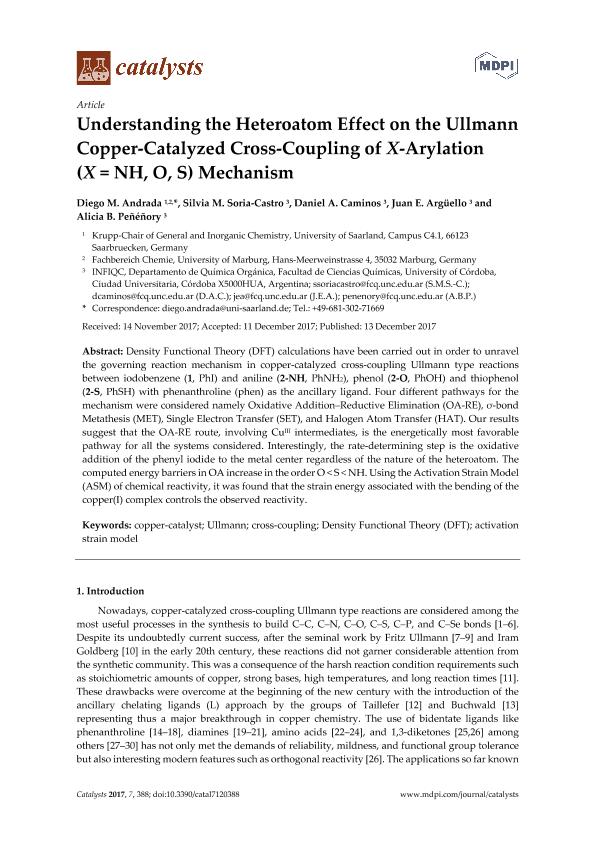Artículo
Understanding Heteroatom Effect on Ullmann Copper-Catalyzed Cross-Coupling of X-Arylation (X = NH, O, S) Mechanism
Andrada, Diego Marcelo ; Soria Castro, Silvia Mercedes
; Soria Castro, Silvia Mercedes ; Caminos, Daniel Alberto
; Caminos, Daniel Alberto ; Argüello, Juan Elias
; Argüello, Juan Elias ; Peñeñory, Alicia Beatriz
; Peñeñory, Alicia Beatriz
 ; Soria Castro, Silvia Mercedes
; Soria Castro, Silvia Mercedes ; Caminos, Daniel Alberto
; Caminos, Daniel Alberto ; Argüello, Juan Elias
; Argüello, Juan Elias ; Peñeñory, Alicia Beatriz
; Peñeñory, Alicia Beatriz
Fecha de publicación:
12/2017
Editorial:
MDPI
Revista:
Catalysts
ISSN:
2073-4344
Idioma:
Inglés
Tipo de recurso:
Artículo publicado
Clasificación temática:
Resumen
Density Functional Theory (DFT) calculations have been carried out in order to unravel the governing reaction mechanism in copper-catalyzed cross-coupling Ullmann type reactions between iodobenzene (1, PhI) and aniline (2-NH, PhNH2), phenol (2-O, PhOH) and thiophenol (2-S, PhSH) with phenanthroline (phen) as the ancillary ligand. Four different pathways for the mechanism were considered namely Oxidative Addition?Reductive Elimination (OA-RE), σ-bond Metathesis (MET), Single Electron Transfer (SET), and Halogen Atom Transfer (HAT). Our results suggest that the OA-RE route, involving CuIII intermediates, is the energetically most favorable pathway for all the systems considered. Interestingly, the rate-determining step is the oxidative addition of the phenyl iodide to the metal center regardless of the nature of the heteroatom. The computed energy barriers in OA increase in the order O < S < NH. Using the Activation Strain Model (ASM) of chemical reactivity, it was found that the strain energy associated with the bending of the copper(I) complex controls the observed reactivity.
Archivos asociados
Licencia
Identificadores
Colecciones
Articulos(INFIQC)
Articulos de INST.DE INVESTIGACIONES EN FISICO- QUIMICA DE CORDOBA
Articulos de INST.DE INVESTIGACIONES EN FISICO- QUIMICA DE CORDOBA
Citación
Andrada, Diego Marcelo; Soria Castro, Silvia Mercedes; Caminos, Daniel Alberto; Argüello, Juan Elias; Peñeñory, Alicia Beatriz; Understanding Heteroatom Effect on Ullmann Copper-Catalyzed Cross-Coupling of X-Arylation (X = NH, O, S) Mechanism; MDPI; Catalysts; 7; 12-2017; 388-405
Compartir
Altmétricas



